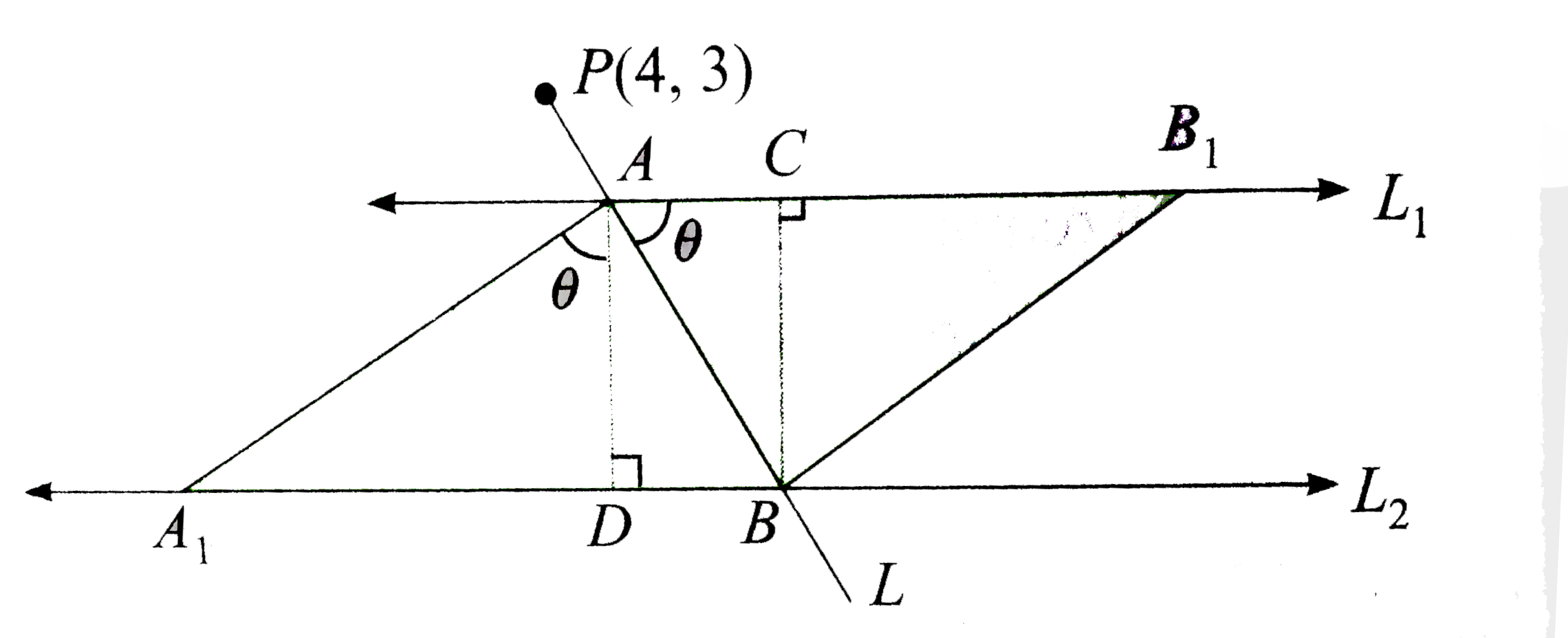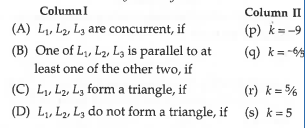A line L is a drawn from P(4,3) to meet the lines L−1andL2 given by 3x+4y+5=0 and 3x+4y+15=0 at points AandB , respectively. From A , a line perpendicular to L is drawn meeting the line L2 at A1. Similarly, from point B1. Thus, a parallelogram ∀1BB1 is formed. Then the equation of L so that the area of the parallelogram ∀1BB1 is the least is x−7y+17=0 7x+y+31=0 x−7y−17=0 x+7y−31=0

The given lines (L1 andL2) are parallel and the distance between them (BC or AD) is (15-5)/5 = 0 units. Let ∠BAC=θ. So, AB = BC cosec θ=2 cosec θ and AA1=AD sec θ=2 sec θ. Now, the area of parallelogram AA1BB1 is
Δ=AB×AA1=4sec θ cosecθ
=8sin2θ
Clearly,Δ is the least forθ=π/4. Let the slope of AB be m. Then,
tan45∘=∣∣∣m+3/41−(3m/4)∣∣∣
or 4m+3=±(4−3m)orm=17or−7
Hence, the equation of L is
x-7y+17=0
or 7x + y -31=0
Topper's Solved these Questions
- STRAIGHT LINESBook:CENGAGEChapter:STRAIGHT LINESExercise:Exercise 2.1
Explore 23 Videos
- STRAIGHT LINESBook:CENGAGEChapter:STRAIGHT LINESExercise:Exercise 2.2
Explore 4 Videos
- STRAIGHT LINEBook:CENGAGEChapter:STRAIGHT LINEExercise:Multiple Correct Answers Type
Explore 8 Videos
- THEORY OF EQUATIONSBook:CENGAGEChapter:THEORY OF EQUATIONSExercise:JEE Advanced Previous Year
Explore 9 Videos
Similar Questions
A line is a drawn from P(4,3) to meet the lines L1andl2 given by 3x+4y+5=0and3x+4y+15=0 at points AandB respectively. From A , a line perpendicular to L is drawn meeting the line L2 at A1 Similarly, from point B1 Thus a parallelogram ∀1BB1 is formed. Then the equation of L so that the area of the parallelogram ∀1BB1 is the least is (a) x−7y+17=0 (b) 7x+y+31=0 (c) x−7y−17=0 (d) x+7y−31=0
View SolutionThe area of the parallelogram formed by the lines 3x + 4y = 7a; 3x + 4y = 7b; 4x + 3y-7c and 4x+3y = 7d is-
View Solution
Knowledge Check
A variable line L is drawn through O(0,0) to meet the line L1 and L2 given by y-x-10 =0 and y-x-20=0 at Points A and B, respectively.
Locus of P, if OP2=OA×OB, isA(y−x)2=100B(y+x)2=50C(y−x)2=200Dnone of these
Find the equation of line parallel to the y-axis and drawn through the point of intersection of x 7y+ 5 = 0and 3x+y 7 = 0.
View SolutionFind the equation of the line parallel to the y-axis and drawn through the point of intersection of the lines x−7y+15=0and2x+y=0.
View SolutionFind the equation of the tangent line to the curve y=3x2−1x at the point (1,2) is
(a) 4x-y-1=0
(b) 4x+y+2=0
(c)x-y-1=0
(d) 4x-y-2=0
View SolutionFind the length of perpendicular drawn from point (2,−1) to the line 3x+4y−11=0.
View SolutionFind the equation of the line parallel to y-axis and drawn through the point of intersection of the lines x−7y+5=0 and 3x+y=0.
View SolutionFind the values of the parameter a so that the point (a, 2) is an interior point of the triangle formed by the lines x+y-4=0, 3x-7y-8=0and 4x-y-31 = 0.
View SolutionConsider the lines give by L1:x+3y−5=0,L2:3x−ky−1=0,L3:5x+2y−12=0

View Solution
